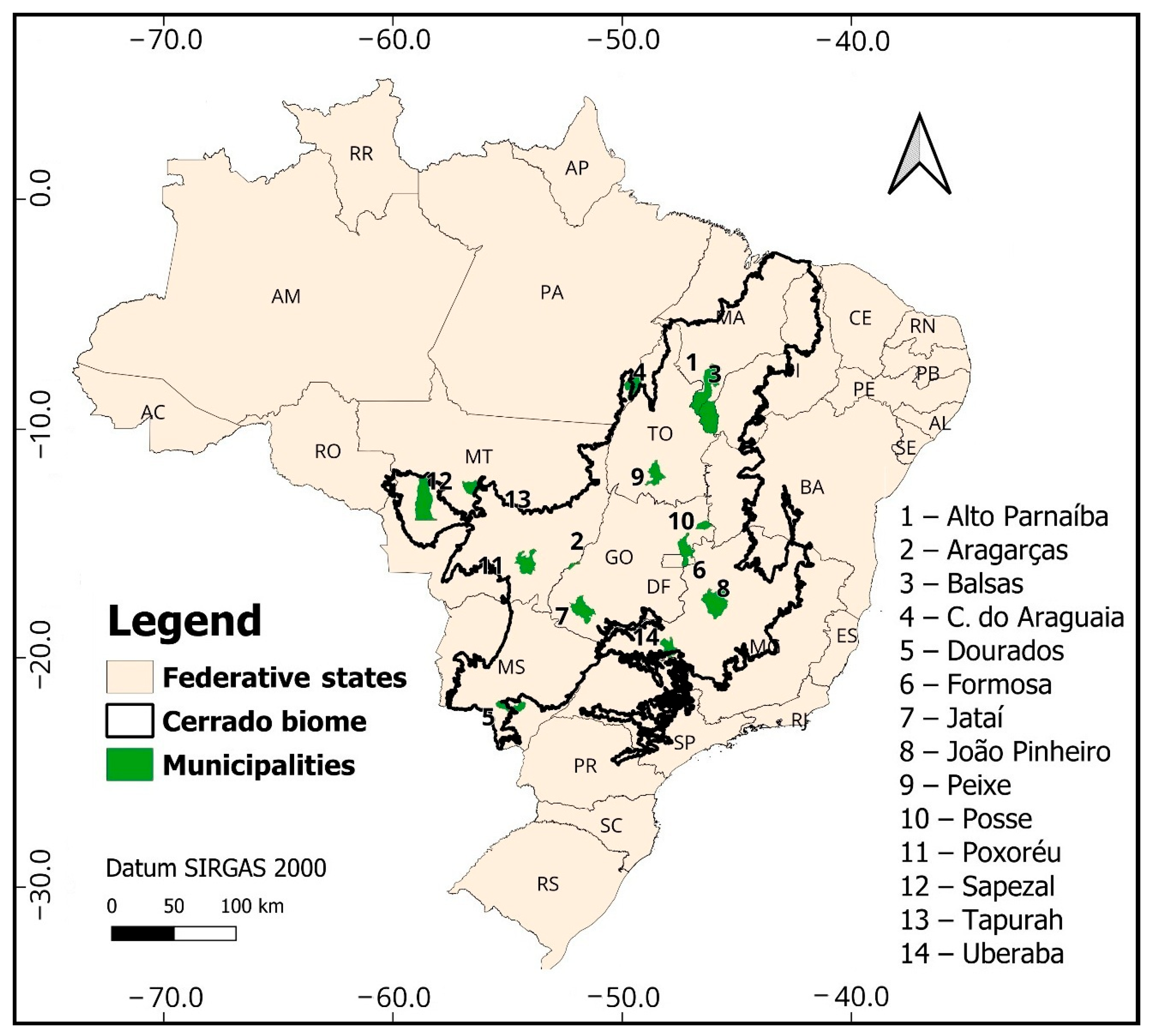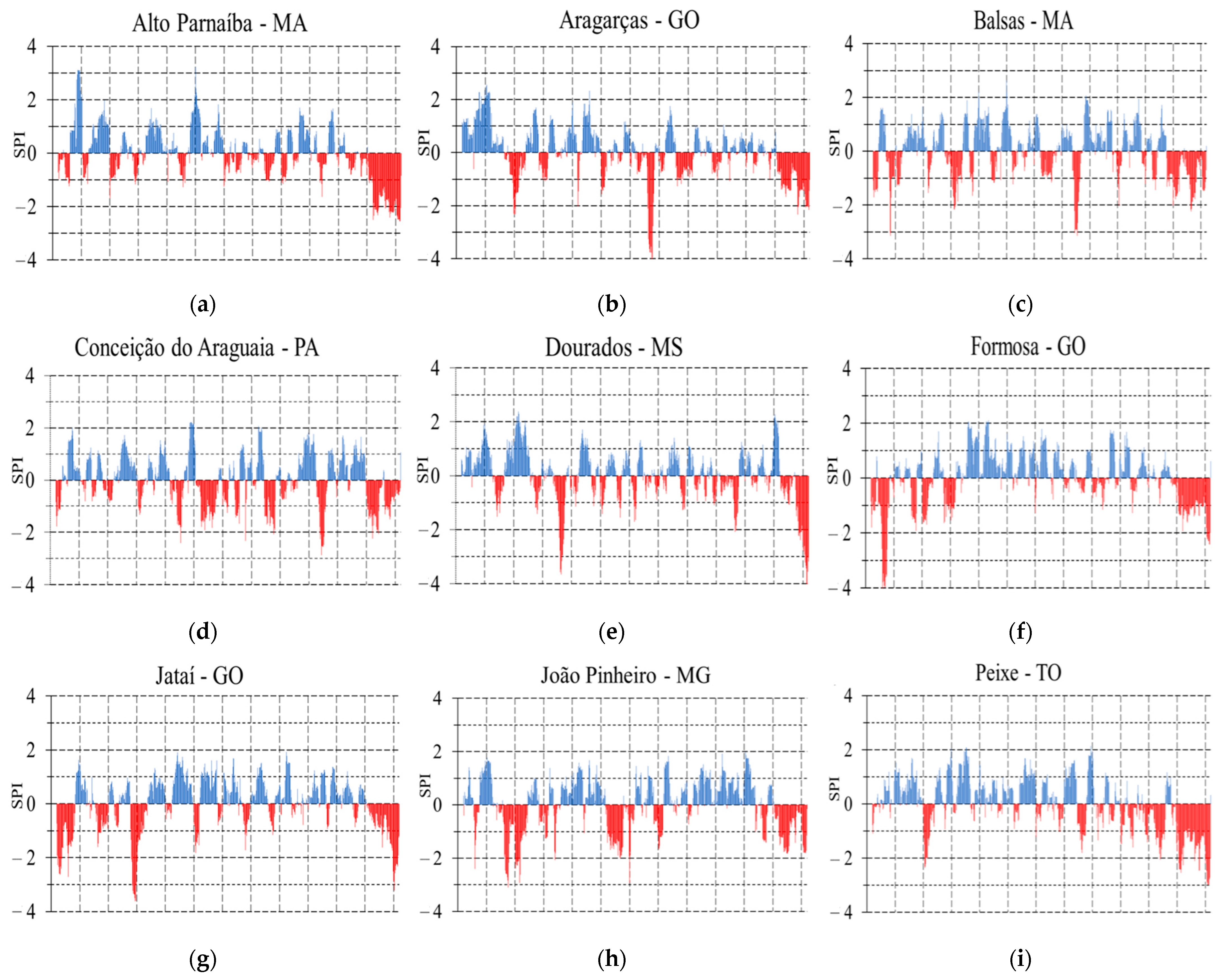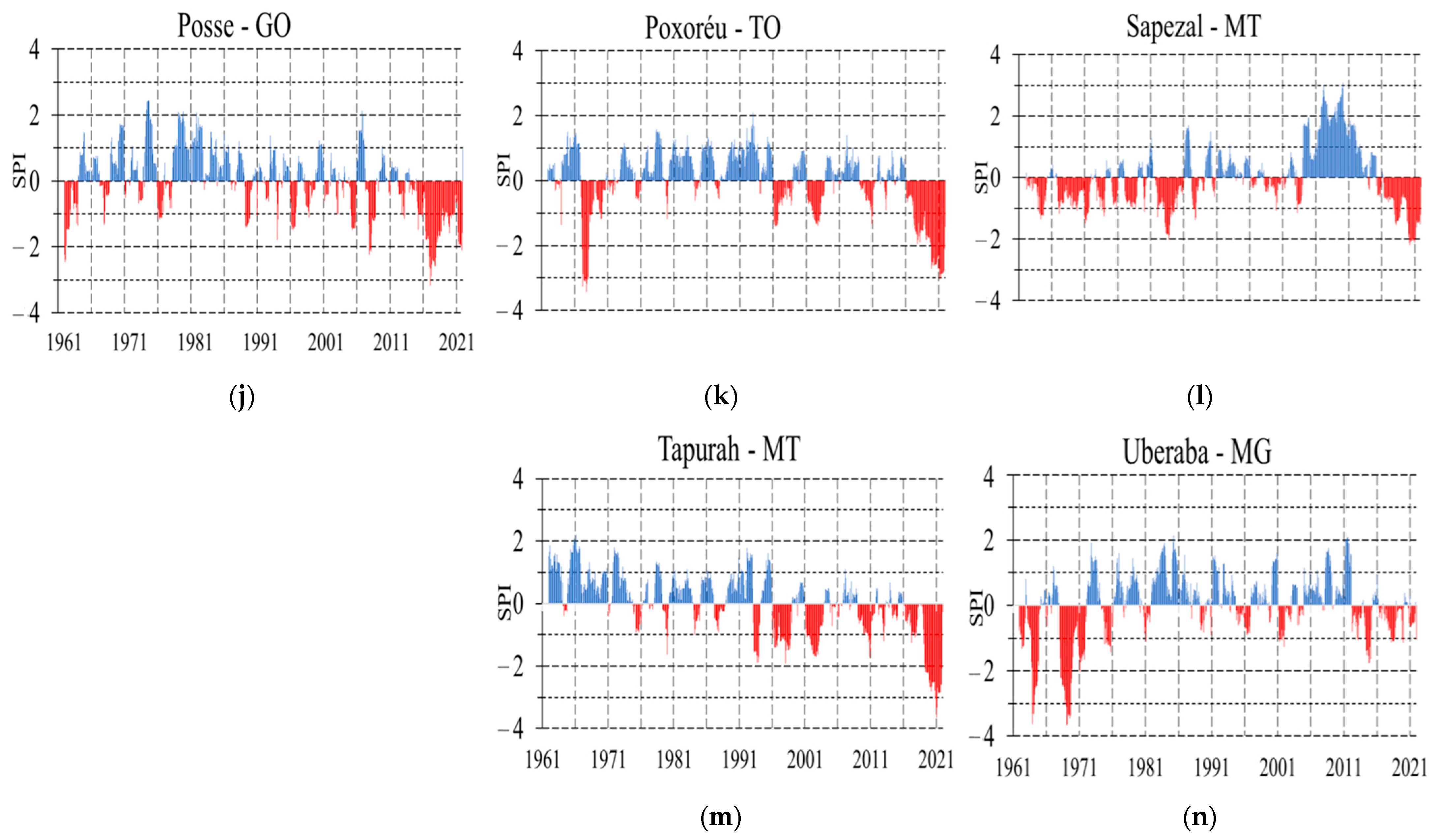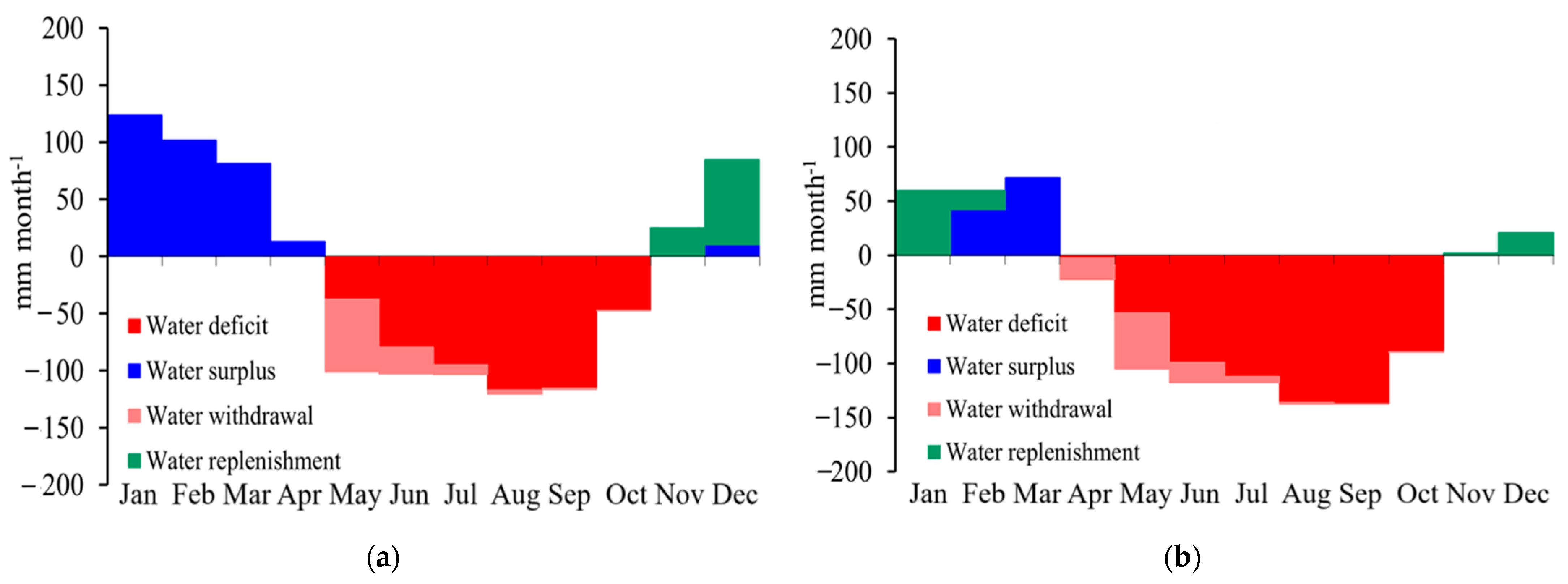Shifting Climate Patterns in the Brazilian Savanna Evidenced by the Köppen Classification and Drought Indices
Abstract
1. Introduction
2. Materials and Methods
2.1. Study Area
2.2. Climate Data

2.3. Köppen Climate Classification
2.4. Standardized Precipitation Index (SPI)
2.5. Mann–Kendall Test and Sen’s Slope
2.6. Climatic Water Balance
2.7. Data Analysis
3. Results
3.1. Köppen Classification
3.2. Standardized Precipitation Index (SPI)
3.3. Mann–Kendall Test and Sen’s Slope
3.4. Climate Normal Series
3.5. Climatic Water Balance
4. Discussion
5. Conclusions
Author Contributions
Funding
Institutional Review Board Statement
Informed Consent Statement
Data Availability Statement
Acknowledgments
Conflicts of Interest
References
- Ribeiro, J.F.; Walter, B.M.T. As principais fitofisionomias do bioma Cerrado. In Cerrado: Ecologia e Flora, 1st ed.; Sano, S.M., Almeida, S.P., Ribeiro, J.F., Eds.; Embrapa Informação Tecnológica: Brasília, Brazil, 2008; pp. 151–212. [Google Scholar]
- Mamede, J.S.S.; Pasa, M.C. Diversidade e uso de plantas do Cerrado na comunidade São Miguel, Várzea Grande, MT, Brasil. Interações 2019, 20, 1087–1098. [Google Scholar] [CrossRef]
- Alvares, C.A.; Stape, J.L.; Sentelhas, P.C.; Gonçalves, J.L.M.; Sparovek, G. Köppen’s climate classification map for Brazil. Meteorol. Z. 2013, 22, 711–728. [Google Scholar] [CrossRef] [PubMed]
- Assad, E.D.; Victoria, D.D.C.; Cuadra, S.V.; Pugliero, V.S.; Zanetti, M.R. Efeito das mudanças climáticas na agricultura do Cerrado. In Dinâmica Agrícola no Cerrado: Análises e Projeções; Bolfe, E.L., Sano, E.E., Campos, S.K., Eds.; Embrapa: Brasília, Brazil, 2020; pp. 213–228. [Google Scholar]
- Joly, C.A.; Scarano, F.R.; Seixas, C.S.; Metzger, J.P.; Ometto, J.P.; Bustamante, M.M.C.; Padgurschi, M.C.G.; Pires, A.P.F.; Castro, P.F.D.; Gadda, T.; et al. 1° Diagnóstico Brasileiro de Biodiversidade e Serviços Ecossistêmicos, 1st ed.; Editora Cubo: São Carlos, Brazil, 2019; pp. 93–213. [Google Scholar]
- MapBiomas. Projeto MapBiomas—Mapeamento Anual de Cobertura e Uso da Terra no Cerrado—Coleção 7. 2022. Available online: https://brasil.mapbiomas.org/destaques-de-colecoes-anteriores/ (accessed on 3 December 2024).
- Hofmann, G.S.; Cardoso, M.F.; Alves, R.J.V.; Weber, E.J.; Barbosa, A.A.; de Toledo, P.M.; Pontual, F.B.; Salles, L.D.O.; Hasenack, H.; Cordeiro, J.L.P.; et al. The Brazilian Cerrado is becoming hotter and drier. Glob. Change Biol. 2021, 27, 4060–4073. [Google Scholar] [CrossRef]
- Teodoro, P.E.; Silva Junior, C.A.; Delgado, R.C.; Lima, M.; Teodoro, L.P.R.; Baio, F.H.R.; Azevedo, G.B.; Azevedo, G.T.O.S.; Pantaleão, A.A.; Capristo-Silva, G.F.; et al. Twenty-year impact of fire foci and its relationship with climate variables in Brazilian regions. Environ. Mont. Assess. 2022, 194, e90. [Google Scholar] [CrossRef]
- Silva, A.S.A.; Menezes, R.S.C.; Stosic, T. Multifractal analysis of standardized precipitation index in Northeast Brazil. Chaos Solitons Fractals 2023, 172, 113600. [Google Scholar] [CrossRef]
- IPCC. Synthesis Report. Contribution of Working Groups I, II and III to the Sixth Assessment Report of the Intergovernmental Panel on Climate Change; Lee, H., Romero, J., Eds.; IPCC: Geneva, Switzerland, 2023; p. 184. [Google Scholar]
- Ferreira, F.L.V.; Rodrigues, L.N.; Silva, F.B. Performance evaluation of climate models in the simulation of precipitation and average temperature in the Brazilian Cerrado. Theor. Appl. Climatol. 2024, 155, 845–857. [Google Scholar] [CrossRef]
- Feng, X.; Tian, H.; Cong, J.; Zhao, C. A method review of the climate change impact on crop yield. Front. For. Glob. Change 2023, 6, 1198186. [Google Scholar] [CrossRef]
- Carley, D.S.; Cook, J.; Emerine, S. Agricultural issues with climate change—Case studies with 3 soybean pests: Johnsongrass, kudzu bug, and charcoal rot. J. Integr. Pest Manag. 2024, 15, 3. [Google Scholar] [CrossRef]
- Oliveira, H.R.; Cassemiro, F.A.S. Potenciais efeitos das mudanças climáticas futuras sobre a distribuição de um anuro da Caatinga Rhinella granulosa (Anura, Bufonidae). Iheringia Série Zool. 2013, 103, 272–279. [Google Scholar] [CrossRef]
- Silva, L.P.; Battisti, R.; Knapp, F.M.; Santos, T.G.; Junior, J.A. Estimativa da produtividade de soja usando irrigação na época das chuvas no bioma Cerrado. Agrometeoros 2020, 28, e026702. [Google Scholar] [CrossRef]
- Gupta, A.; Rico-Medina, A.; Caño-Delgado, A.I. The physiology of plant responses to drought. Science 2020, 368, 266–269. [Google Scholar] [CrossRef] [PubMed]
- Hanberry, B.B. Global climate classification and comparison to Mid-Holocene and Last Glacial Maximum climates, with added aridity information and a hypertropical class. Earth 2023, 4, 552–569. [Google Scholar] [CrossRef]
- Martins, F.B.; Gonzaga, G.; dos Santos, D.F.; Reboita, M.S. Classificação climática de Köppen e de Thornthwaite para Minas Gerais: Cenário atual e projeções futuras. Rev. Bras. Climatol. 2018, 14, 129–156. [Google Scholar] [CrossRef]
- Rolim, G.S.; Aparecido, L.E. Köppen and Thornthwaite climate classification systems in defining climatical regions of the state of São Paulo, Brazil. Int. J. Climatol. 2016, 36, 636–643. [Google Scholar] [CrossRef]
- Alvares, C.A.; Stape, J.L.; Sentelhas, P.C.; de Moraes Gonçalves, J.L.; Sparovek, G. Southeastern Brazil inland tropicalization: Köppen system applied for detecting climate change throughout 100 years of meteorological observed datas. Theor. Appl. Climatol. 2022, 149, 1431–1450. [Google Scholar] [CrossRef]
- Cui, D.; Liang, S.; Wang, D. Observed and projected changes in global climate zones based on Köppen climate classification. Wiley Interdiscip. Rev. Clim. Change 2021, 12, e707. [Google Scholar] [CrossRef]
- Instituto Nacional de Meteorologia (INMET). Banco de Dados Meteorológicos do INMET. Available online: https://bdmep.inmet.gov.br/ (accessed on 9 July 2024).
- National Aeronautics and Space Administration (NASA) POWER. Prediction of Worldwide Energy Resources. Available online: https://power.larc.nasa.gov/data-access-viewer/ (accessed on 16 August 2023).
- Battisti, R.; da Silva, O.C.C.; Knapp, F.M.; Alves Júnior, J.; Mesquita, M.; Monteiro, L.A. Assessment of the reliability to use NASAPOWER gridded weather applied to irrigation planning and management in Brazil. Theor. Appl. Climatol. 2024, 155, 8287–8297. [Google Scholar] [CrossRef]
- Agência Nacional de Águas e Saneamento Básico (ANA). Hidroweb: Sistemas de Informações Hidrológicas. Available online: https://www.snirh.gov.br/hidroweb/apresentacao (accessed on 6 April 2024).
- Battisti, R.; Bender, F.D.; Sentelhas, P.C. Assessment of different gridded weather data for soybean yield simulations in Brazil. Theor. Appl. Climatol. 2019, 135, 237–247. [Google Scholar] [CrossRef]
- Instituto Brasileiro de Geografia e Estatística (IBGE). Mapas Interativos: Solos. Available online: http://mapas.ibge.gov.br/ (accessed on 4 August 2023).
- Kottek, M.; Grieser, J.; Beck, C.; Rudolf, B.; Rubel, F. World Map of the Köppen-Geiger climate classification updated. Meteorol. Z. 2006, 15, 259–263. [Google Scholar] [CrossRef]
- McKee, T.B.; Doesken, N.J.; Kleist, J. The Relationship of Drought Frequency and Duration to Time Scales. In Proceedings of the 8th Conference on Applied Climatology, Anaheim, CA, USA, 17–22 January 1993; pp. 179–184. [Google Scholar]
- Battisti, R.; Dapper, F.P.; da Silva, A.C.S.; Mesquita, M.; da Silva, M.V.; Andrade, R.R.; Lopes, A.G.C. Assessing Precipitation Trends Between 1960 and 2021 Using Multiple Trend Indexes in the Goiás State and Federal District, Brazil. Int. J. Climatol. 2025, 45, e8750. [Google Scholar] [CrossRef]
- Mann, H.B. Non-Parametric Tests Against Trend. Econometrica 1945, 13, 245–259. [Google Scholar] [CrossRef]
- Kendall, M.G. Rank Correlation Methods, 4th ed.; Charles Griffin: London, UK, 1975. [Google Scholar]
- Sen, P.K. Estimates of the Regression Coefficient Based on Kendall’s Tau. J. Am. Stat. Assoc. 1968, 63, 1379–1389. [Google Scholar] [CrossRef]
- Cabral, J.B., Jr.; Lucena, R.L. Análises das precipitações pelos testes não paramétricos de Mann-Kendall e Kruskal-Wallis. Mercator 2020, 19, e19001. [Google Scholar] [CrossRef]
- Thornthwaite, C.W.; Mather, J.R. The Water Balance; Drexel Institute of Technology, Laboratory of Climatology: Centerton, NJ, USA, 1955; Volume 8, pp. 1–104. [Google Scholar]
- Rolim, G.S.; Sentelhas, P.C.; Barbieri, V. Planilhas no ambiente EXCEL™ para os cálculos de balanços hídricos: Normal, sequencial, de cultura e de produtividade real e potencial. Rev. Bras. Agrometeorol. 1998, 6, 133–137. [Google Scholar]
- Köppen, W. Das geographische System der Klimate. In Handbuch der Klimatologie; Köppen, W., Geiger, R., Eds.; Gebrüder Bornträger: Berlin, Germany, 1936; Volume 1, pp. 1–44. [Google Scholar]
- Moura, M.S.B.; Galvincio, J.D.; Brito, L.T.L.; Souza, L.S.B.; Sá, I.I.S.; Silva, T.G.F. Clima e água de chuva no semiárido. In Potencialidades da Água de Chuva no Semiárido Brasileiro; Embrapa Semiárido: Petrolina, PE, USA, 2007; pp. 37–59. [Google Scholar]
- Tomasella, J.; Cunha, A.P.A.; Marengo, J.A. Nota Técnica: Elaboração dos Mapas de Índice de Aridez e Precipitação Total Acumulada para o Brasil; Ministério da Ciência, Tecnologia e Inovação: Brasília, Brazil, 2023. [Google Scholar]
- Jardim, C.H.; Galvani, E.; Silva, M.R.; Garcia, R.A. O clima em áreas limítrofes ao planalto meridional do Espinhaço: Belo Horizonte, Sete Lagoas e Conceição do Mato Dentro, Minas Gerais-Brasil. Rev. Bras. Climatol. 2019, 25, 549–570. [Google Scholar] [CrossRef]
- Muylaert, L.R.; Vancine, H.M.; Bernardo, R.; Oshima, J.E.F.; Souza, T.S.; Tonetti, V.R.; Niebuhr, B.B.; Ribeiro, M.C. Uma nota sobre os limites territoriais da Mata Atlântica. Oecol. Aust. 2018, 22, 302–311. [Google Scholar] [CrossRef]
- Malvestio, L.M.; Teixeira Nery, J. A importância da Amazônia para o regime pluviométrico da região sudeste do Brasil. Rev. Geonorte 2012, 3, 786–795. [Google Scholar]
- Silva, G.K.; Marcos Júnior, A.D.; Lima, C.E.S.; Silva, M.V.M.; Silveira, C.S.; Silva, E.M.; Lima, I.R. Análise da Variabilidade Espaço-Temporal do SPI: Um Estudo de Caso para a Sub-Bacia Choró, Ceará, Brasil. Rev. Bras. Meteorol. 2021, 36, 539–549. [Google Scholar] [CrossRef]
- Lima, R.F.; Aparecido, L.E.O.; Torsoni, G.B.; Rolim, G.S. Climate change assessment in Brazil: Utilizing the Köppen-Geiger (1936) climate classification. Rev. Bras. Metorol. 2023, 38, e38230001. [Google Scholar] [CrossRef]
- Penereiro, J.C.; Meschiatti, M.C. Tendências em séries anuais de precipitação e temperaturas no Brasil. Eng. Sanit. Ambient. 2018, 23, 319–331. [Google Scholar] [CrossRef]
- Tarmizi, A.H.A.; Rahmat, S.N.; Karim, A.T.A.; Tukimat, N.N.A. Climate change and its impact on rainfall. Int. J. Integr. Eng. 2019, 11, 170–177. Available online: https://publisher.uthm.edu.my/ojs/index.php/ijie/article/view/4288/2227 (accessed on 3 July 2024).
- Batista, F.S.; Duku, C.; Hein, L. Deforestation-induced changes in rainfall decrease soybean-maize yields in Brazil. Ecol. Model. 2023, 486, 110533. [Google Scholar] [CrossRef]
- Silva, E.S.; Zavislak, F.; Dallacort, R.; Carvalho, M.A.; Araújo, D. Distribuição da probabilidade de chuva no município de Sapezal, MT. Enciclop. Biosf. 2013, 9, 1112. [Google Scholar]
- Hofmann, G.S.; Silva, R.C.; Weber, E.J.; Barbosa, A.A.; Oliveira, L.F.B.; Alves, R.J.V.; Cardoso, M.F. Changes in atmospheric circulation and evapotranspiration are reducing rainfall in the Brazilian Cerrado. Sci. Rep. 2023, 13, 11236. [Google Scholar] [CrossRef]
- Battisti, R.; Sentelhas, P.C.; Pilau, F.G.; Wollmann, C.A. Eficiência climática para as culturas da soja e do trigo no estado do Rio Grande do Sul em diferentes datas de semeadura. Ciênc. Rural. 2013, 43, 390–396. [Google Scholar] [CrossRef]
- Fernandes, R.D.M.; de Melo, D.M.; Elli, E.F.; Battisti, R. Climate change impacts on rainfed and irrigated soybean yield in Brazil’s new agricultural frontier. Theor. Appl. Climatol. 2022, 147, 803–816. [Google Scholar] [CrossRef]
- Velasko, S.J.W.; Villalobos, F.; Galvão, F.; Marco Júnior, P.D. A dark scenario for Cerrado plant species: Effects of future climate, land use and protected areas ineffectiveness. Bio. Res. 2019, 25, 660–673. [Google Scholar] [CrossRef]
- Battisti, R.; Sentelhas, P.C.; Boote, K.J. Sensitivity and requirement of improvements of four soybean crop simulation models for climate change studies in Southern Brazil. Int. J. Biometeorol. 2017, 62, 823–832. [Google Scholar] [CrossRef]
- Battisti, R.; Sentelhas, P.C. New agroclimatic approach for soybean sowing dates recommendation: A case study. Rev. Bras. Eng. Agríc. Ambient. 2014, 18, 1149–1156. [Google Scholar] [CrossRef]
- Battisti, R.; Silva Neto, W.A.; Costa, R.M.; Dapper, F.P.; Elli, E.F. Irrigation demand for fruit trees under a climate change scenario using artificial intelligence. Pesqui. Agropecu. Trop. 2024, 54, e77917. [Google Scholar] [CrossRef]



| Municipalities, State | Z | Sen (°C Year−1) | p-Value 1 |
|---|---|---|---|
| Alto Parnaíba, MA | +7.2941 | +0.0302 | <0.0001 ** |
| Aragarças, GO | +5.8938 | +0.0218 | <0.0001 ** |
| Balsas, MA | +5.6451 | +0.0241 | <0.0001 ** |
| Conceição do Araguaia, PA | +8.0216 | +0.0605 | <0.0001 ** |
| Dourados, MS | +6.8589 | +0.0329 | <0.0001 ** |
| Formosa, GO | +7.7950 | +0.0362 | <0.0001 ** |
| Jataí, GO | +5.8146 | +0.0202 | <0.0001 ** |
| João Pinheiro, MG | +7.3247 | +0.0475 | <0.0001 ** |
| Peixe, TO | +6.8273 | +0.0296 | <0.0001 ** |
| Posse, GO | +6.7341 | +0.0314 | <0.0001 ** |
| Poxoréu, MT | +4.2453 | +0.0156 | 0.0218 * |
| Sapezal, MT | +0.5228 | +0.0018 | 0.6011 ns |
| Tapurah, MT | +4.9539 | +0.0328 | <0.0001 ** |
| Uberaba, MG | +5.0911 | +0.0252 | <0.0001 ** |
| Municipalities, State | Z | Sen (mm Year−1) | p-Value 1 |
|---|---|---|---|
| Alto Parnaíba, MA | −3.0181 | −6.23 | 0.0025 ** |
| Aragarças, GO | −3.1799 | −7.19 | 0.0015 ** |
| Balsas, MA | −0.4169 | −0.75 | 0.6767 ns |
| Conceição do Araguaia, PA | −0.4294 | −1.17 | 0.6676 ns |
| Dourados, MS | −2.3896 | −4.54 | 0.0169 * |
| Formosa, GO | −0.6410 | −1.70 | 0.5215 ns |
| Jataí, GO | +0.1680 | +0.37 | 0.8666 ns |
| João Pinheiro, MG | −0.3671 | −0.91 | 0.7135 ns |
| Peixe, TO | −3.0057 | −6.24 | 0.0026 ** |
| Posse, GO | −2.2838 | −5.62 | 0.0224 ** |
| Poxoréu, MT | −2.5701 | −7.53 | 0.0102 ** |
| Sapezal, MT | +1.9104 | +6.02 | 0.0560 ns |
| Tapurah, MT | −4.6610 | −12.77 | <0.0001 ** |
| Uberaba, MG | +0.3547 | +0.9187 | 0.7228 ns |
| Municipalities, State | Precipitation | Air Temperature | ||||
|---|---|---|---|---|---|---|
| 1961–1990 | 1992–2021 | Difference | 1961–1990 | 1992–2021 | Difference | |
| mm Year−1 | °C | |||||
| Alto Parnaíba, MA | 1426 | 1213 | −213 | 26.3 | 27.3 | +1.0 |
| Aragarças, GO | 1604 | 1355 | −249 | 25.9 | 26.7 | +0.8 |
| Balsas, MA | 1211 | 1161 | −50 | 26.7 | 27.6 | +0.9 |
| Conceição do Araguaia, PA | 1662 | 1627 | −35 | 26.1 | 28.0 | +1.9 |
| Dourados, MS | 1468 | 1348 | −120 | 22.6 | 23.7 | +1.1 |
| Formosa, GO | 1325 | 1293 | −32 | 22.1 | 23.2 | +1.1 |
| Jataí, GO | 1529 | 1548 | +19 | 23.3 | 24.0 | +0.7 |
| João Pinheiro, MG | 1224 | 1302 | +78 | 22.7 | 24.2 | +1.5 |
| Peixe, TO | 1572 | 1387 | −185 | 26.6 | 27.6 | +1.0 |
| Posse, GO | 1513 | 1328 | −185 | 23.9 | 25.0 | +1.1 |
| Poxoréu, MT | 1973 | 1763 | −210 | 25.1 | 25.8 | +0.7 |
| Sapezal, MT | 1775 | 2189 | +414 | 26.2 | 26.1 | −0.1 |
| Tapurah, MT | 2212 | 1812 | −400 | 25.3 | 26.6 | +1.3 |
| Uberaba, MG | 1561 | 1606 | +45 | 22.8 | 23.6 | +0.8 |
| Municipalities, State | Water Deficit | Water Surplus | ||||
|---|---|---|---|---|---|---|
| 1961–1990 | 1992–2021 | Difference | 1961–1990 | 1992–2021 | Difference | |
| mm Year−1 | °C | |||||
| Alto Parnaíba, MA | 491 | 629 | +138 | 330 | 113 | −217 |
| Aragarças, GO | 384 | 509 | +125 | 449 | 224 | −225 |
| Balsas, MA | 558 | 671 | +113 | 96 | 54 | −42 |
| Conceição do Araguaia, PA | 393 | 558 | +165 | 502 | 369 | −133 |
| Dourados, MS | 1 | 4 | +3 | 327 | 82 | −245 |
| Formosa, GO | 216 | 287 | +71 | 482 | 421 | −61 |
| Jataí, GO | 146 | 162 | +16 | 487 | 440 | −47 |
| João Pinheiro, MG | 242 | 370 | +128 | 346 | 387 | +41 |
| Peixe, TO | 470 | 626 | +156 | 407 | 254 | −153 |
| Posse, GO | 327 | 418 | +91 | 605 | 367 | −238 |
| Poxoréu, MT | 274 | 343 | +69 | 853 | 611 | −242 |
| Sapezal, MT | 292 | 265 | −27 | 489 | 881 | +392 |
| Tapurah, MT | 263 | 436 | +173 | 1044 | 610 | −434 |
| Uberaba, MG | 108 | 166 | +58 | 532 | 556 | +24 |
Disclaimer/Publisher’s Note: The statements, opinions and data contained in all publications are solely those of the individual author(s) and contributor(s) and not of MDPI and/or the editor(s). MDPI and/or the editor(s) disclaim responsibility for any injury to people or property resulting from any ideas, methods, instructions or products referred to in the content. |
© 2025 by the authors. Licensee MDPI, Basel, Switzerland. This article is an open access article distributed under the terms and conditions of the Creative Commons Attribution (CC BY) license (https://creativecommons.org/licenses/by/4.0/).
Share and Cite
Soares, K.W.d.S.; Battisti, R.; Dapper, F.P.; Carvalho, A.P.M.d.; Silva, M.V.d.; Silva, J.L.B.d.; de Oliveira, H.F.E.; Mesquita, M. Shifting Climate Patterns in the Brazilian Savanna Evidenced by the Köppen Classification and Drought Indices. Atmosphere 2025, 16, 849. https://doi.org/10.3390/atmos16070849
Soares KWdS, Battisti R, Dapper FP, Carvalho APMd, Silva MVd, Silva JLBd, de Oliveira HFE, Mesquita M. Shifting Climate Patterns in the Brazilian Savanna Evidenced by the Köppen Classification and Drought Indices. Atmosphere. 2025; 16(7):849. https://doi.org/10.3390/atmos16070849
Chicago/Turabian StyleSoares, Khályta Willy da Silva, Rafael Battisti, Felipe Puff Dapper, Alexson Pantaleão Machado de Carvalho, Marcos Vinícius da Silva, Jhon Lennon Bezerra da Silva, Henrique Fonseca Elias de Oliveira, and Marcio Mesquita. 2025. "Shifting Climate Patterns in the Brazilian Savanna Evidenced by the Köppen Classification and Drought Indices" Atmosphere 16, no. 7: 849. https://doi.org/10.3390/atmos16070849
APA StyleSoares, K. W. d. S., Battisti, R., Dapper, F. P., Carvalho, A. P. M. d., Silva, M. V. d., Silva, J. L. B. d., de Oliveira, H. F. E., & Mesquita, M. (2025). Shifting Climate Patterns in the Brazilian Savanna Evidenced by the Köppen Classification and Drought Indices. Atmosphere, 16(7), 849. https://doi.org/10.3390/atmos16070849










